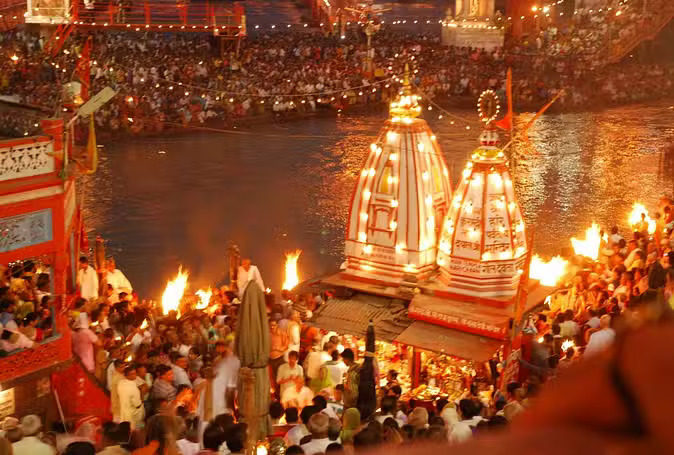
Kumbh Mela -image by Photo Find
🕉️ 1. Introduction: Leap of Faith at the Kumbh
The Kumbh Mela, held every 12 years at Haridwar (Uttarakhand), along with Prayagraj, Nashik, and Ujjain, is deeply rooted in Hindu legend—“kumbh” refers to the pot of nectar (Amrit), and these four sites mark where the nectar drops were believed to fall añduring the cosmic churning of the ocean . At its heart lies the communal plunge into sacred waters—a leap of faith that symbolizes purification, spiritual rebirth, and the washing away of sins.
2. Mythological Significance
Legend has it that after the gods (Devas) and demons (Asuras) churned the cosmic ocean to obtain Amrit, Himalaya’s eagle Garuda carried the kumbh away. During this flight, drops fell at Haridwar, Prayagraj, Nashik, and Ujjain. Thus, cycles of Kumbh Mela are drawn to these sites every 12 years, aligned with astronomical configurations—especially Jupiter’s transit into Aquarius (Kumbh Rashi) and the Sun’s entry into Aries
3. Kumbh Across Time: Haridwar’s Legacy
Haridwar’s Kumbh tradition dates back centuries. Chinese pilgrim Hsuan Tsang described mass gatherings in the 7th century CE. By medieval times, it had become a grand confluence of spiritual sadhus, merchants, pilgrims, rulers, and even colonial officials—merchant caravans from Persia to Arabia thronged the fair. British accounts of 1814 report 500,000 pilgrims, including Sikhs, Nawabs, and Europeans . Despite occasional stampedes and cholera outbreaks, it persisted—indeed, the British improved ghats and infrastructure after major crowd incidents
4. The Spiritual Tapestry
The Mela is steeped in Hindu spiritual ethos. Ascetics from diverse Akharas—especially the naked Nagas—lead the processions. Their ash-covered bodies symbolize renunciation, discipline, and extreme devotional practice Ritual baths in the Ganga at Har Ki Pauri, believed to be the very spot where Ganga enters the plains (literally “feet of Vishnu”), hold immense symbolic value. Many saints teach that this dip is more than ritual—it’s absorption into cosmic consciousness, a surrender to the divine
Pilgrims experience “a convergence of faith, culture, and humanity”—where differences fall away, and the bond of shared spiritual aspiration shines through
5. Kumbh 2025: Back at Haridwar
Following the Maha Kumbh in Prayagraj in early 2025, Haridwar’s Ardh Kumbh in 2027 will be the next major event . However, in May 2025, the Pushkar Kumbh at Mana, Uttarakhand marked a significant moment—held at Keshav Prayag near Badrinath’s Alaknanda–Saraswati confluenceWhile not the Maha Kumbh, these events sustain regional devotional fervor and spread ecological and spiritual awareness.
6. The 2025 Prayagraj Maha Kumbh: Scale, Success, and Strain
Though not in Haridwar, the 2025 Maha Kumbh in Prayagraj offers insights usurpable for Haridwar.
- Scale: Reported attendance reached 660 million individuals during the six-week festival—making it possibly the largest spiritual gathering in history .
- Within the first 14 days alone, 110 million devotees took the ritual dip
- Infrastructure & Management: A 4,000-hectare “pop-up city” with 200,000 tents, 250-mile roads, and 30 pontoon bridges was set up in under four months.
- Innovation: Logistics included water jets for sanitation, 60,000 IoT-enabled portable toilets (with gender/disability access), real-time waste systems, renewable energy, CCTV monitoring, AI surveillance, and cashless digital governance
7. Tragedies Amidst Triumphs
However, tragedy marred even the best-laid plans:
- In Prayagraj, a crushing stampede near pontoon bridges early on Jan 29 killed 30–39 people
- Research shows such stampedes are often at predictable chokepoints—riverbank exits, VIP route management failures—and tragically repeat history due to systemic memory loss
- Uttarakhand’s High Court has cautioned that mass gatherings like Kumbh can lead to disasters, especially combined with Chardham pilgrimages
8. Sustainability as Spiritual Duty
The Kumbh Mela has evolved from ritual to responsibility. The fusion of faith and environment has become central.
- Reusable biodegradable utensils, plastics bans, waste segregation, and compost systems
- Water conservation campaigns and treatment plants to protect sacred rivers
- Renewable energy: solar lighting, wind turbines, bioenergy units .
- Massive tree-planting around ghats, “Oxygen Hubs”, and ecological restoration drives
9. Managing the “Pop-Up Megacity”
Haridwar’s Kumbh—like Prayagraj’s Maha Kumbh—is a temporary city, and the spectacle lies in its logistics.
Infrastructure:
- 156 km of roads, 30+ pontoon bridges, 770 km of electrical cables.
- 20,000 water taps, 40 tube wells.
- 35,000 individual toilets and 7,500 trench toilets .
- 12k+ specially trained state police, 30 temporary police stations
- Advanced disease surveillance, ambulances, fire teams, disaster readiness .
10. Economic & Social Resonance
Beyond spirituality, the Mela catalyzes local economies:
- Millions of pilgrims generate massive demand—hotels, dhabas, shops, guides
- In Prayagraj, typical pilgrim spending averaged ₹200/day—cumulatively billions of rupees
- Haridwar boasts around 800 hotels and 350 ashrams—future Kumbh events could mean ₹4–5 k crore in revenue
Behind this economic boom lies a push-pull: development vs. crowd safety and environmental responsibility.
11. Haridwar 2027: The Next Test
Though on a smaller scale than Maha Kumbh, Haridwar’s Ardh Kumbh in 2027 presents complex challenges:
- History: Haridwar’s last full Kumbh was in 2021; Ardh Kumbh in 2027 builds on that
- Devotion: Millions will gather at Har Ki Pauri—spiritually charged location with deep mythic resonance
- Logistics: Will reuse the proven blueprints—tents, roads, water, digital ops, policing—yet must improve past mistakes .
- Environment: Scaling up sustainable measures—solar, waste composting, plastic bans, river treatment campaigns .
- Safety: Addressing stampede risks: better crowd modeling, smarter exit strategies, avoid VIP-induced chokepoints.
12. Lessons for Sustainable Faith Gatherings
Drawing from Haridwar, Prayagraj, and global analogues, Kumbh offers profound lessons:
- Ancient Ritual + Modern Planning: Rituals aligned with astrological cycles maintain spiritual authenticity while infrastructure and tech create feasible logistics .
- Crowd Analytics: Integrating crowd modeling, AI cameras, IoT sensors—especially at exits and bridges—can prevent future tragedies .
- Eco-Spiritual Integration: Teaching environmental responsibility at pilgrimage points the way mass bathing is taught—turning faith into action
- Inclusive Infrastructure: Gender- and disability-conscious facilities, mental health zones, medical aid, paramedics—all essential .
- Community Ownership: Engaging local communities, volunteers, youth, NGOs as extensions of spiritual duty strengthens resilience .

